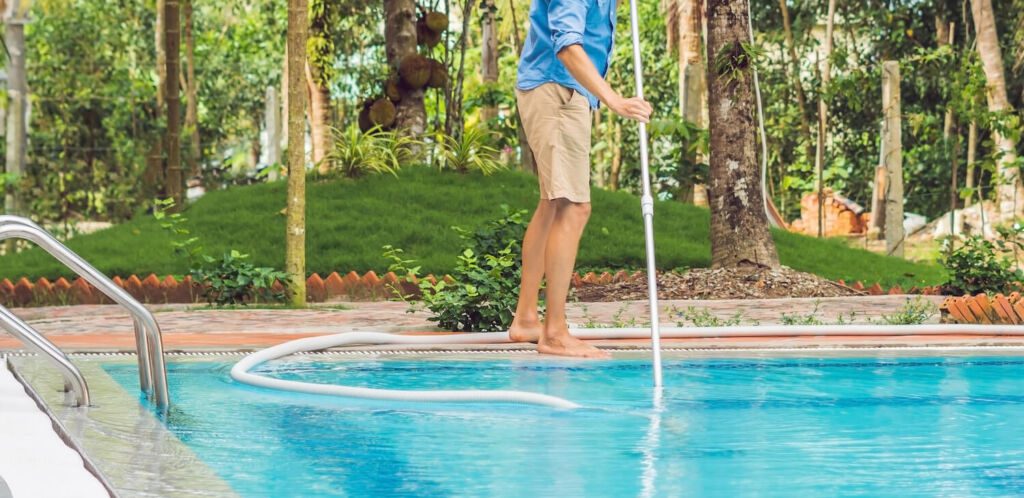While mustard can be the perfect condiment for your hot dog, sandwich or hamburger, you never want to see mustard algae, also known as yellow algae, in your pool or spa.
If left untreated mustard algae can wreak havoc on your pool surfaces, equipment and water quality, but luckily it is treatable and preventable. With simple steps, you can enjoy crystal clear, healthy water without mustard algae or the threat of it forming again.
To identify, treat and prevent mustard algae in your pool or spa water, follow our steps below.
What is Mustard Algae?
Before treating your pool or spa, we need to first know what mustard algae is to identify it in the water. So, can you swim in a pool with mustard algae? A close relative to green algae, mustard algae can be yellowish, yellow-green or brown in color and is typically slimy. Commonly mistaken for dirt or sand, mustard algae will persistently cling to pool surfaces, light fixtures, wall fittings, ladders and other items, like toys or bathing suits.
Mustard algae is typically found in warmer climates, but it can grow in any pool or spa. Unfortunately, mustard algae is common and without proper water care any pool or spa surface can be susceptible to it. Since mustard algae is chlorine resistant, it can be tricky to get rid of once it finds a home in your pool or spa. It is important to address mustard algae immediately because it can quickly transfer from pool surfaces to toys, floats and bathing suits. While mustard algae can be brushed off, you’ll want to treat it correctly to ensure it doesn’t return.
How to Treat Mustard Algae
Once you’ve determined that your pool or spa has a mustard algae outbreak, you’ll need to take immediate action to remove it. Here are some step-by-step instructions on how to treat a mustard algae outbreak.
1. Remove and wash your toys, floats, etc.
First, remove all items that aren’t attached to your pool or spa, like toys, floats and other accessories. Mustard algae will latch onto toys, equipment and swimsuits and these items can continue to reintroduce the spores to your water if they aren’t sanitized.
Disinfect your items using a multipurpose cleaner that will kill mustard algae without causing damage to your possessions, such as Clorox multipurpose cleaner. Be careful of using bleach or cleaners with bleach because it can discolor your items and is not recommended. For your swimsuits, use a color-safe laundry detergent to wash and kill off any mustard algae in the fabric. Additionally, suction or pressure side cleaners can be left in the pool and will be addressed in step 4.
2. Brush and vacuum surfaces
Turn off the pump and brush all of your pool and/or spa surfaces. Afterward, use a vacuum to remove the mustard algae debris that has fallen into the pool or onto the spa floor. Brushing will help loosen the mustard algae to make it easier for the shock to kill it and to vacuum it up.
It’s also recommended to use a wire bristle brush, but test an area first to assure no damage to the plaster. Please note, for fiberglass and vinyl liner pools, use only regular nylon brushes. If the two above methods of vacuuming are not an option, use the regular vacuum process to remove the mustard algae debris. Mustard algae can also live in the filter, so a thorough backwash or cleaning of the filter will be necessary.
3. Test and balance your water chemistry
Make sure your water is properly balanced, with a pH level between 7.2 and 7.4 and an alkalinity level between 60 and 120 ppm. Balanced pool or spa water will help set up the chlorine shock for optimal performance. For outdoor pools or indoor pools using trichlor, make sure your cyanuric acid ppm levels range between 20 and 40 ppm. High cyanuric acid levels render sanitation ineffective and can skew alkalinity readings, so proper cyanuric acid levels are very important.
4. Superchlorinate your pool or spa
Superchlorination, also known as shocking, is the process of adding several times more chlorine to the pool water than what is normally needed. With superchlorination, the chlorine can “burn” through resistant compounds, chemicals, oils and strong types of algae. We recommend to superchlorinate your pool or spa with calcium hypochlorite, such as cal-hypo granular, or sodium hypochlorite, such as liquid bleach. To maximize efficiency, add your shock to the water at dusk or at night and leave your filter and pump running 24 hours a day until the mustard algae is gone. Remember, always be sure to follow the manufacturer’s shock pool water application instructions.
Usually, mustard algae can be eradicated if the dose of superchlorination shock is 10 ppm. But, as you can see from the water chemistry chart sourced from the legendary Robert Lowry, 10 ppm of chlorine will not be appropriate for higher CYA levels in the pool to kill off the mustard algae. So, shock accordingly.



5. Balance and clean water for a few days
After the superchlorination, continue to test and balance the water for a few days. The extreme amount of chlorine that was added will affect the water’s chemistry, so be sure to bring it back into balance. In addition, continue to brush the pool as normal for a few more days.
If the slightest bit of mustard algae has reappeared, repeat the process immediately. It is best practice to eradicate the mustard algae, even if the dose of superchlorination shock is at regular strength of 10 ppm. Backwash and or clean the filter media when the process is completed and apply a pro-active algaecide to the pool to complete the final step.
How to Prevent Mustard Algae
The good news about mustard algae is that it is preventable. Proactive water care is the key to make sure that mustard algae doesn’t appear on your pool or spa surfaces. To prevent mustard algae outbreaks, follow the proper pool and spa care procedures listed below.
1. Keep your water chemistry balanced
Unbalanced water chemistry can wreak havoc on your pool or spa surfaces and equipment. Remember to regularly test the water and keep the pH, alkalinity, calcium hardness, cyanuric acid etc. levels in the proper ranges:
- pH Levels: 7.2 – 7.4
- Alkalinity: 60 – 120 ppm
- Calcium Hardness: 200 – 400 ppm (for plaster pools) or 150 – 250 ppm (for vinyl liner and fiberglass pools)
- Cyanuric Acid: 20 – 40 ppm (for outdoor pools)
- Total Dissolved Solids: 1500 ppm or less (4500 ppm or less for salt pools)
- Phosphates: 200 ppb or less
2. Practice proper filtration
Without proper filtration, impurities can build up resulting in a higher risk for mustard algae to bloom. Make sure to run your filtration system for at least 12 hours a day. If you have a Clear Comfort AOP pool, we recommend 24-hour circulation with an energy-efficient variable-speed pump.
3. Clean your surfaces
Make sure to regularly vacuum and brush your pool or spa surfaces. Brushing the pool or spa is imperative to prevent mustard algae spores from colonizing on surfaces.
4. Always have a sanitizer
Keep a measurable level of sanitizer in your pool water. For pools and spas with Clear Comfort AOP treatment systems, the chlorine can stay at drinking-water levels or less.
5. Circulation
Circulation moves water through your filter, removing particles and debris from your pool or spa water. Without the proper circulation, your pool or spa’s sanitation system, filter and added chemicals can’t function properly. Check your pool’s circulation for any dead zones and adjust your wall return jet fittings appropriately.
6. Use an algaecide
To prevent and kill algae blooms, algaecides provide an effective and fast acting way to protect your swimming pool or spa water. Make sure to proactively treat your water with an algaecide.
7. Clean your filter
Backwashing your pool filter, also known as backwashing your pool, is an important step to keeping your pool or spa water clean. To keep your filter effective, send water backward through the filter to force out any debris, but be sure to follow the manufacturer’s recommendations. If your pool is exposed to extreme organic loading, you may need to backwash more frequently.
Now you are equipped with the knowledge of how to treat and prevent mustard algae, so you can enjoy clear, clean pool or spa water – and leave the mustard for those outdoor barbecue burgers.
Want pool or spa sanitation power beyond chlorine or salt water systems? Powered by a patented Hydroxyl-Based AOP, Clear Comfort’s pool and spa treatment system delivers the easiest way to get the healthiest water that looks as good as it feels. To learn more about the revolutionary science behind Clear Comfort AOP systems, click here.





